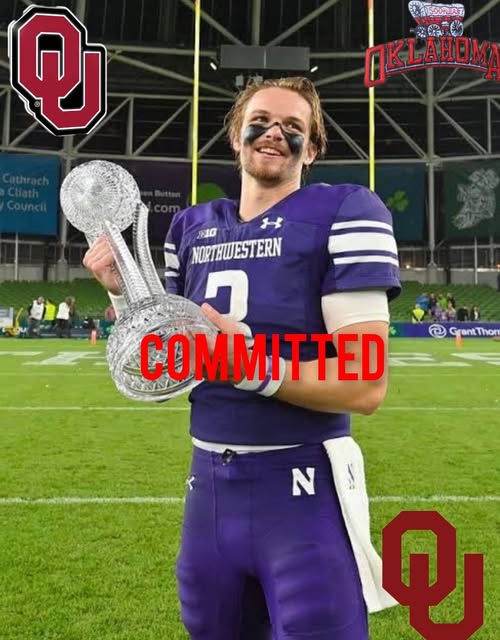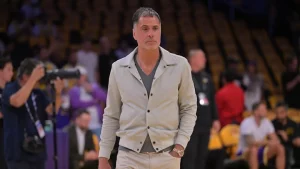
A 5-star wide receiver (WR) has set the college football world on fire with a shocking decision that has stunned fans, analysts, and recruiting experts alike. What initially appeared to be a strong commitment to Northwestern University has taken a dramatic turn, as the highly touted prospect decommitted and instead flipped his commitment to the University of Oklahoma Sooners, despite interest from powerhouses such as Notre Dame, Tennessee, and several others. This move has sent ripples through the world of college football recruiting, leaving many to question the motivations behind such a surprising change in direction.
A Star on the Rise: The 5-Star WR
Before diving into the specifics of the decommitment and commitment flip, it’s essential to understand just how valuable this 5-star wide receiver prospect is. Standing at 6’3″ and possessing incredible athleticism, this wide receiver is a physical marvel on the field. His combination of size, speed, and technical skills has made him one of the most sought-after recruits in the country, with his explosive plays often drawing comparisons to some of the best wide receivers to come through college football in recent memory.
His high school career has been nothing short of spectacular. Dominating opponents with his deep-threat ability, route-running precision, and sheer athleticism, he has broken multiple school records and earned a reputation as a player who can change the game with a single play. Coaches and scouts alike have been enamored with his versatility, as he’s capable of lining up at multiple spots in the receiving corps and making an impact no matter the scheme.
The 5-star WR is also known for his high football IQ, often making adjustments on the fly and finding ways to break free from defensive coverage. He’s not just a raw talent, but a refined and polished player who has learned the nuances of the game and translated that knowledge into success on the field.
The Northwestern Commitment
For much of the recruiting process, it appeared that this star wide receiver was heading to Northwestern University, a school that had managed to pull in a commitment from him early in the process. While Northwestern may not be considered one of the traditional college football powerhouses, the Wildcats have built a respectable program, with strong emphasis on academics and player development. For a prospect like this wide receiver, who also valued education and an atmosphere conducive to his development as both a player and a person, Northwestern seemed like a fitting choice.
Northwestern’s coaching staff, led by head coach Pat Fitzgerald, had worked tirelessly to establish a relationship with the WR. They had showcased how he could be a star in their offense, emphasizing the program’s commitment to developing players at every level. The Wildcats had even made a concerted effort to secure early commitments from top recruits, and this wide receiver’s decision to pledge to them was seen as a testament to the program’s increasing appeal.
Additionally, Northwestern is located in Evanston, Illinois, near Chicago, which presented an appealing option for this WR, both in terms of lifestyle and exposure. Many believed the commitment was a perfect fit for both sides, with Northwestern getting a star player and the WR getting a school that could balance athletics with academics.
However, even with the commitment locked in, there were whispers in the recruiting world that other programs might still have a shot. As is the case with many high-profile recruits, interest from other schools doesn’t simply vanish after a commitment is made.
The Shocking Decommitment
When the news broke that the 5-star WR had decommitted from Northwestern, it immediately sent shockwaves through the college football world. The timing of the decision raised eyebrows, as it occurred when recruiting was ramping up for the early signing period. Typically, decommitments this close to National Signing Day can have a ripple effect on the entire recruiting landscape, with other teams scrambling to assess their options.
At the time of his decommitment, many wondered why he would back off a commitment to a program like Northwestern, especially given how solid it had seemed. Speculation swirled about potential factors behind the change of heart—whether it was a shift in the WR’s personal preferences, dissatisfaction with the direction of Northwestern’s program, or the lure of more prominent football programs with greater resources and national exposure.
In the wake of his decommitment, reporters and analysts quickly began searching for clues that would explain this unexpected move. One of the first things that became apparent was that several powerhouse programs had been in close contact with the WR for weeks leading up to the decommitment. Notre Dame, Tennessee, and Oklahoma had all made significant efforts to get the star player’s attention, and they appeared to have made inroads.
It’s not uncommon for top recruits to receive late pushes from major programs, but the speed with which this WR’s decision appeared to change was unprecedented. It became clear that he was weighing the prospect of playing for a top-tier program with a national title pedigree, and that his options had suddenly expanded in ways that few had anticipated.
The Flip to Oklahoma
A few days after the decommitment from Northwestern, news broke that the WR had officially flipped his commitment to the University of Oklahoma Sooners. This decision sent shockwaves through the recruiting world, as Oklahoma had been in hot pursuit of the WR for some time. The Sooners, under head coach Brent Venables, had already established themselves as one of the premier programs in college football, with a history of success in the Big 12 and a reputation for developing explosive offensive talent.
For Oklahoma, landing this 5-star WR was a monumental victory, not only because of the player’s talent but because it further solidified the Sooners’ status as one of the top programs in the nation. Oklahoma has long been a contender in the college football playoff conversation, and by securing this commitment, the Sooners are further positioning themselves as a powerhouse in the recruiting wars.
Several factors likely contributed to this flip. Oklahoma’s offense, known for its high-powered passing attack, offers a perfect fit for a wide receiver of this caliber. The WR would have the opportunity to play in a system designed to get him the ball in space, allowing him to showcase his skills and develop into one of the most dangerous playmakers in the country. Moreover, the Sooners have a history of developing wide receivers who go on to succeed in the NFL, which undoubtedly played a role in the WR’s decision-making process.
Additionally, the atmosphere at Oklahoma is one that encourages competition, and the chance to play alongside other high-caliber athletes in a pressure-packed environment likely appealed to this WR’s desire to prove himself at the highest level.
The Role of Notre Dame and Tennessee
While Oklahoma ultimately emerged as the victor in the recruitment of this WR, it is important to note that both Notre Dame and Tennessee played significant roles in his decision-making process. Notre Dame, with its storied football program, had been a close contender, but the WR ultimately felt that Oklahoma’s offensive system better suited his playing style and aspirations. The Fighting Irish were known for their balanced approach, and while they are an elite program, they may not have been able to provide the same explosive offensive environment that Oklahoma could offer.
Tennessee, meanwhile, had been building momentum under head coach Josh Heupel, and their strong showing in recent seasons made them an appealing option. However, it seems that the allure of playing in Oklahoma’s offense, coupled with the Sooners’ consistent success, made it clear that Norman was the right fit for this 5-star WR.
Implications for Oklahoma
With this commitment, Oklahoma continues to establish itself as a dominant force in college football recruiting. The Sooners are on track to assemble a class that rivals any in the nation, with a mix of offensive and defensive talent that should help them remain a perennial contender for the college football playoff. The addition of a 5-star WR adds another weapon to an already potent offense and signals that the Sooners are preparing for another national championship push.
This commitment is also a significant statement to other programs across the country. It’s not just a win for Oklahoma, but a sign that the program is on the rise once again, especially under the leadership of head coach Brent Venables, who has begun to restore Oklahoma’s luster as a top-tier program.




